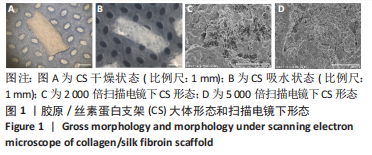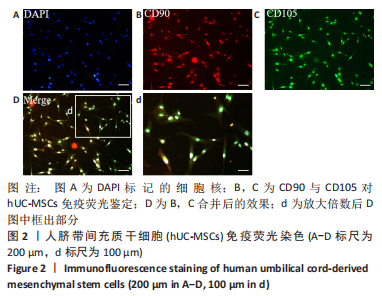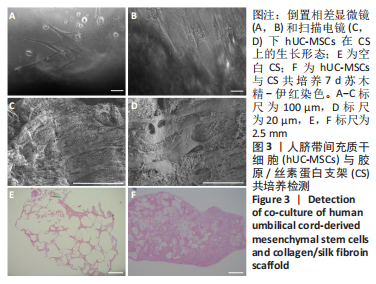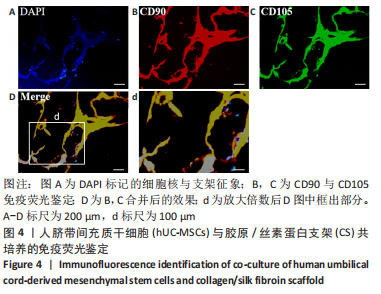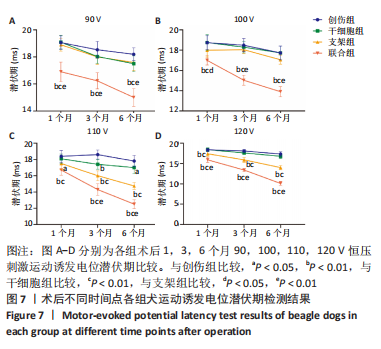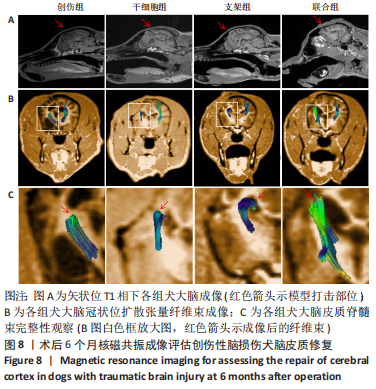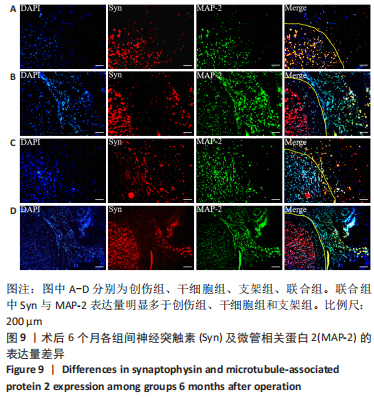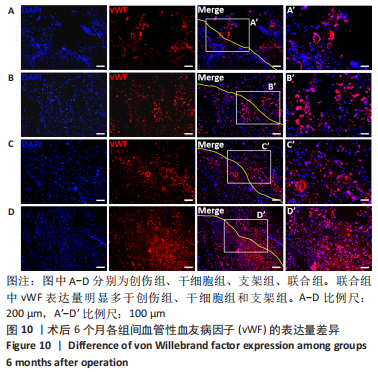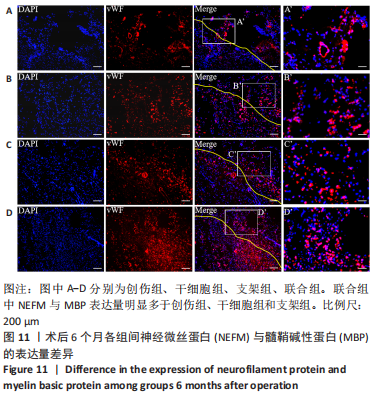Chinese Journal of Tissue Engineering Research ›› 2023, Vol. 27 ›› Issue (34): 5483-5490.doi: 10.12307/2023.725
Previous Articles Next Articles
Collagen/silk fibroin scaffold combined with human umbilical cord-derived mesenchymal stem cells in the treatment of traumatic brain injury in dogs
Wang Ziqi1, 2, Li Xiaoyin2, Jiang Jipeng3, Song Zhen1, 2, Li Zhengchao2, Chen Shulian2, Chen Xuyi2
- 1Graduate School of Tianjin University of Traditional Chinese Medicine, Tianjin 301617, China; 2Research Institute of Maritime Rights Defense Medical Support, Chinese People’s Armed Police Force Characteristic Medical Center, Tianjin Key Laboratory of Neurotrauma Repair, Tianjin 300162, China; 3General Hospital of Chinese People’s Liberation Army, Beijing 100039, China
-
Received:2022-10-13Accepted:2022-11-18Online:2023-12-08Published:2023-04-22 -
Contact:Chen Xuyi, MD, Researcher, Doctoral supervisor, Research Institute of Maritime Rights Defense Medical Support, Chinese People’s Armed Police Force Characteristic Medical Center, Tianjin Key Laboratory of Neurotrauma Repair, Tianjin 300162, China -
About author:Wang Ziqi, Master candidate, Graduate School of Tianjin University of Traditional Chinese Medicine, Tianjin 301617, China; Research Institute of Maritime Rights Defense Medical Support, Chinese People’s Armed Police Force Characteristic Medical Center, Tianjin Key Laboratory of Neurotrauma Repair, Tianjin 300162, China Li Xiaoyin, Master, Research intern, Research Institute of Maritime Rights Defense Medical Support, Chinese People’s Armed Police Force Characteristic Medical Center, Tianjin Key Laboratory of Neurotrauma Repair, Tianjin 300162, China -
Supported by:National Science and Technology Key Research & Development Plan, No. 2016YFC1101500 (to CXY); National Defense Science and Technology Excellence Youth Science Fund, No. 2021-JCJQ-ZQ-035 (to CXY); Scientific Research and Innovation Team of Armed Police Characteristic Medical Center, No. KYCXTD0104 (to LZC)
CLC Number:
Cite this article
Wang Ziqi, Li Xiaoyin, Jiang Jipeng, Song Zhen, Li Zhengchao, Chen Shulian, Chen Xuyi. Collagen/silk fibroin scaffold combined with human umbilical cord-derived mesenchymal stem cells in the treatment of traumatic brain injury in dogs[J]. Chinese Journal of Tissue Engineering Research, 2023, 27(34): 5483-5490.
share this article
Add to citation manager EndNote|Reference Manager|ProCite|BibTeX|RefWorks

2.4 改良格拉斯哥评分 术后1 d以及1,4,8,12,16,20,24周分别进行改良格拉斯哥评分。术后1 d组间各项改良格拉斯哥评分无明显差异,术后1-16周,干细胞组、支架组改良格拉斯哥评分有高于创伤组的趋势,但无明显统计学意义。术后1,4,8,12,16,20,24周联合组改良格拉斯哥评分极其显著高于创伤组(P < 0.01);术后8,12,16周,联合组改良格拉斯哥评分显著高于干细胞组与支架组(P < 0.05);术后1,4,20,24周,联合组改良格拉斯哥评分极其显著高于干细胞组(P < 0.01);术后1,20,24周,联合组改良格拉斯哥评分极其显著高于支架组(P < 0.01),见图5。"


2.5 运动诱发电位检测结果 2.5.1 振幅比较 干细胞组与支架组在一定时间节点振幅显著高于创伤组,而大部分时间节点显著低于联合组。90 V、1个月和3个月,110 V、6个月时,创伤组振幅均显著或极其显著低于干细胞组(P < 0.05或P < 0.01);除90 V、6个月,其余情况下创伤组振幅均显著或极其显著低于支架组(P < 0.05或P < 0.01);所有检测条件下干细胞组振幅均显著或极其显著低于联合组(P < 0.05或P < 0.01);90 V,1,3,6个月和110 V,6个月情况下,支架组振幅非常显著低于联合组(P < 0.01),见图6。结果表明hUC-MSCs联合CS能够显著提高创伤性脑损伤犬的运动诱发电位振幅,且效果明显优于单纯hUC-MSCs和CS。"
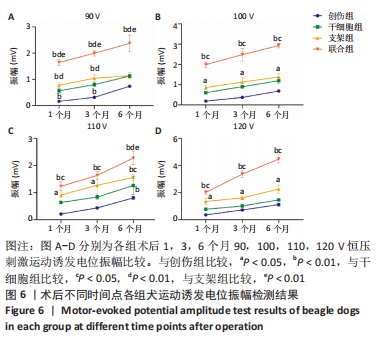
| [1] MENON DK, SCHWAB K, WRIGHT DW, et al. Position statement: definition of traumatic brain injury. Arch Phys Med Rehabil. 2010;91(11):1637-1640. [2] GBD 2016 NEUROLOGY COLLABORATORS. Global, regional, and national burden of neurological disorders, 1990-2016: a systematic analysis for the Global Burden of Disease Study 2016. Lancet Neurol. 2019;18(5):459-480. [3] MAAS AIR, FITZGERALD M, GAO G, et al. Traumatic brain injury over the past 20 years: research and clinical progress. Lancet Neurol. 2022;21(9):768-770. [4] JIANG JY, GAO GY, FENG JF, et al. Traumatic brain injury in China. Lancet Neurol. 2019;18(3):286-295. [5] ANCANS J. Cell therapy medicinal product regulatory framework in Europe and its application for MSC-based therapy development. Front Immunol. 2012;3:253. [6] HOANG DM, PHAM PT, BACH TQ, et al. Stem cell-based therapy for human diseases. Signal Transduct Target Ther. 2022;7(1):272. [7] MAAS AIR, MENON DK, ADELSON PD, et al. Traumatic brain injury: integrated approaches to improve prevention, clinical care, and research. Lancet Neurol. 2017;16(12):987-1048. [8] DEWAN MC, RATTANI A, GUPTA S, et al. Estimating the global incidence of traumatic brain injury. J Neurosurg. 2019;130(4):1080-1097. [9] ISMAIL H, SHAKKOUR Z, TABET M, et al. Traumatic Brain Injury: Oxidative Stress and Novel Anti-Oxidants Such as Mitoquinone and Edaravone. Antioxidants (Basel). 2020;9(10):943. [10] NAKAO M, INANAGA D, NAGASE K, et al. Characteristic differences of cell sheets composed of mesenchymal stem cells with different tissue origins. Regen Ther. 2019;11:34-40. [11] ZHAO J, YU G, CAI M, et al. Bibliometric analysis of global scientific activity on umbilical cord mesenchymal stem cells: a swiftly expanding and shifting focus. Stem Cell Res Ther. 2018;9(1):32. [12] EL OMAR R, BEROUD J, STOLTZ JF, et al. Umbilical cord mesenchymal stem cells: the new gold standard for mesenchymal stem cell-based therapies? Tissue Eng Part B Rev. 2014;20(5):523-544. [13] SUN W, GREGORY DA, TOMEH MA, et al. Silk Fibroin as a Functional Biomaterial for Tissue Engineering. Int J Mol Sci. 2021;22(3):1499. [14] BUITRAGO JO, PATEL KD, EL-FIQI A, et al. Silk fibroin/collagen protein hybrid cell-encapsulating hydrogels with tunable gelation and improved physical and biological properties. Acta Biomater. 2018;69:218-233. [15] TU Y, CHEN C, SUN HT, et al. Combination of temperature-sensitive stem cells and mild hypothermia: a new potential therapy for severe traumatic brain injury. J Neurotrauma. 2012;29(14):2393-2403. [16] LIU X, ZHANG G, WEI P, et al. Three-dimensional-printed collagen/chitosan/secretome derived from HUCMSCs scaffolds for efficient neural network reconstruction in canines with traumatic brain injury. Regen Biomater. 2022; 9:rbac043. [17] JIANG J, DAI C, NIU X, et al. Establishment of a precise novel brain trauma model in a large animal based on injury of the cerebral motor cortex. J Neurosci Methods. 2018;307:95-105. [18] CAMERON S, WELTMAN JG, FLETCHER DJ. The prognostic value of admission point-of-care testing and modified Glasgow Coma Scale score in dogs and cats with traumatic brain injuries (2007-2010): 212 cases. J Vet Emerg Crit Care (San Antonio). 2022;32(1):75-82. [19] ZHU W, CHEN L, WU Z, et al. Bioorthogonal DOPA-NGF activated tissue engineering microunits for recovery from traumatic brain injury by microenvironment regulation. Acta Biomater. 2022;150:67-82. [20] HSU RS, LI SJ, FANG JH, et al. Wireless charging-mediated angiogenesis and nerve repair by adaptable microporous hydrogels from conductive building blocks. Nat Commun. 2022;13(1):5172. [21] SUN D, LIU K, LI Y, et al. Intrinsically Bioactive Manganese–Eumelanin Nanocomposites Mediated Antioxidation and Anti‐Neuroinflammation for Targeted Theranostics of Traumatic Brain Injury. Adv Healthc Mater. 2022; 11(16):e2200517. [22] WEIGHTMAN AP, PICKARD MR, YANG Y, et al. An in vitro spinal cord injury model to screen neuroregenerative materials. Biomaterials. 2014;35(12): 3756-3765. [23] CHAU AL, GETTY PT, RHODE AR, et al. Superlubricity of pH-responsive hydrogels in extreme environments. Front Chem. 2022;10:891519. [24] JIANG S, YU Z, ZHANG L, et al. Effects of different aperture-sized type I collagen/silk fibroin scaffolds on the proliferation and differentiation of human dental pulp cells. Regen Biomater. 2021;8(4):rbab028. [25] MARTÍN-MARTÍN Y, FERNÁNDEZ-GARCÍA L, SANCHEZ-REBATO MH, et al. Evaluation of Neurosecretome from Mesenchymal Stem Cells Encapsulated in Silk Fibroin Hydrogels. Sci Rep. 2019;9(1):8801. [26] SHAH R, STODULKA P, SKOPALOVA K, et al. Dual Crosslinked Collagen/Chitosan Film for Potential Biomedical Applications. Polymers (Basel). 2019; 11(12):2094. [27] JIANG X, WU S, KUSS M, et al. 3D printing of multilayered scaffolds for rotator cuff tendon regeneration. Bioact Mater. 2020;5(3):636-643. [28] MEBARKI M, ABADIE C, LARGHERO J, et al. Human umbilical cord-derived mesenchymal stem/stromal cells: a promising candidate for the development of advanced therapy medicinal products. Stem Cell Res Ther. 2021;12(1):152. [29] LI J, XU SQ, ZHAO YM, et al. Comparison of the biological characteristics of human mesenchymal stem cells derived from exfoliated deciduous teeth, bone marrow, gingival tissue, and umbilical cord. Mol Med Rep. 2018;18(6):4969-4977. [30] XIE Q, LIU R, JIANG J, et al. What is the impact of human umbilical cord mesenchymal stem cell transplantation on clinical treatment? Stem Cell Res Ther. 2020;11(1):519. [31] SUN L, WANG F, CHEN H, et al. Co-Transplantation of Human Umbilical Cord Mesenchymal Stem Cells and Human Neural Stem Cells Improves the Outcome in Rats with Spinal Cord Injury. Cell Transplant. 2019;28(7):893-906. [32] CAO T, CHEN H, HUANG W, et al. hUC-MSC-mediated recovery of subacute spinal cord injury through enhancing the pivotal subunits β3 and γ2 of the GABAA receptor. Theranostics. 2022;12(7):3057-3078. [33] CHEN C, HU N, WANG J, et al. Umbilical cord mesenchymal stem cells promote neurological repair after traumatic brain injury through regulating Treg/Th17 balance. Brain Res. 2022;1775:147711. [34] CUI L, LUO W, JIANG W, et al. Human umbilical cord mesenchymal stem cell-derived exosomes promote neurological function recovery in rat after traumatic brain injury by inhibiting the activation of microglia and astrocyte. Regen Ther. 2022;21:282-287. [35] OSIER N, DIXON CE. The Controlled Cortical Impact Model of Experimental Brain Trauma: Overview, Research Applications, and Protocol. Methods Mol Biol. 2016;1462:177-192. [36] JIANG J, LIU X, CHEN H, et al. 3D printing collagen/heparin sulfate scaffolds boost neural network reconstruction and motor function recovery after traumatic brain injury in canine. Biomater Sci. 2020;8(22):6362-6374. [37] OLSEN A, BABIKIAN T, DENNIS EL, et al. Functional Brain Hyperactivations Are Linked to an Electrophysiological Measure of Slow Interhemispheric Transfer Time after Pediatric Moderate/Severe Traumatic Brain Injury. J Neurotrauma. 2020;37(2):397-409. [38] SHARMA D, HOLOWAYCHUK MK. Retrospective evaluation of prognostic indicators in dogs with head trauma: 72 cases (January-March 2011). J Vet Emerg Crit Care (San Antonio). 2015;25(5):631-639. [39] SAENUBOL P, AKATVIPAT A, PLEUMSAMRAN A, et al. Correlation between bispectral index value and modified Glasgow Coma Scale score in dogs with altered level of consciousness. J Vet Emerg Crit Care (San Antonio). 2021;31(1):52-58. [40] JANG SH, LEE SJ. Corticoreticular Tract in the Human Brain: A Mini Review. Front Neurol. 2019;10:1188. [41] LI D, JIAO YM, WANG L, et al. Surgical outcome of motor deficits and neurological status in brainstem cavernous malformations based on preoperative diffusion tensor imaging: a prospective randomized clinical trial. J Neurosurg. 2018;130(1):286-301. [42] JANG SH, KIM SH, KWON YH. Extensive traumatic axonal injury of brain due to violence: A case report. Medicine (Baltimore). 2018;97(48): e13315. [43] DOUGLAS DB, RO T, TOFFOLI T, et al. Neuroimaging of Traumatic Brain Injury. Med Sci (Basel). 2018;7(1):2. [44] LACALLE-AURIOLES M, CASSEL DE CAMPS C, ZORCA CE, et al. Applying hiPSCs and Biomaterials Towards an Understanding and Treatment of Traumatic Brain Injury. Front Cell Neurosci. 2020;14:594304. [45] LV B, ZHANG X, YUAN J, et al. Biomaterial-supported MSC transplantation enhances cell-cell communication for spinal cord injury. Stem Cell Res Ther. 2021;12(1):36. [46] MONTICELLI S, NATOLI G. Short-term memory of danger signals and environmental stimuli in immune cells. Nat Immunol. 2013;14(8): 777-784. [47] ZHU D, JIANG Z, LI N, et al. Insights into the use of genetically modified decellularized biomaterials for tissue engineering and regenerative medicine. Adv Drug Deliv Rev. 2022;188:114413. |
| [1] | Wen Xinghua, Ding Huanwen, Cheng Kai, Yan Xiaonan, Peng Yuanhao, Wang Yuning, Liu Kang, Zhang Huiwu. Three-dimensional finite element model analysis of intramedullary nailing fixation design for large femoral defects in Beagle dogs [J]. Chinese Journal of Tissue Engineering Research, 2023, 27(9): 1371-1376. |
| [2] | Cui Lianxu, Jiang Wenkang, Lu Dahong, Xu Junrong, Liu Xiaocui, Wang Bingyun. Clinical-grade human umbilical cord mesenchymal stem cells affect the improvement of neurological function in rats with traumatic brain injury [J]. Chinese Journal of Tissue Engineering Research, 2023, 27(6): 835-839. |
| [3] | Wan Zhe, Du Jun, Hu Yang. Effects of Gushukang on transforming growth factor beta1 and beta-catenin during molar intrusion in Beagle dogs [J]. Chinese Journal of Tissue Engineering Research, 2023, 27(28): 4502-4506. |
| [4] | Lin Shukai, Liu Zhonghai, Liu Zhen, Cai Jincheng, Wei Ruting. Role of m6A RNA methylation modification in necrotic apoptosis in a rat model of brain injury [J]. Chinese Journal of Tissue Engineering Research, 2023, 27(20): 3167-3172. |
| [5] | Liu Chuang, Tan Longwang, Zhou Heshan, Zhang Chi. Adipose-derived mesenchymal stem cell exosomes for treating traumatic central nervous system injury [J]. Chinese Journal of Tissue Engineering Research, 2023, 27(19): 3061-3069. |
| [6] | Shan Wen, Shi Wei. Expression and function of colony-stimulating factor 1 in differentiation of neural stem cells induced by activated astrocyte conditioned medium [J]. Chinese Journal of Tissue Engineering Research, 2022, 26(13): 2069-2074. |
| [7] | Yi Zhishuang, Wang Zhihai, Li Ming, Zhou Qingan, Yang Baosheng. Exosomes from human umbilical cord-derived mesenchymal stem cells suppress the proliferation and promote the apoptosis of medulloblastoma Daoy cells [J]. Chinese Journal of Tissue Engineering Research, 2021, 25(31): 4945-4949. |
| [8] | Li Xiangze, Bu Xianmin, Li Dongmei, Chi Yulei, Su Qiang, Jin Xintong, Zhao Jian, Zhang Gaotian, Wu Bin, Meng Chunyang . Stem cells, cytokines, hormones, neuropeptides and genes in traumatic brain trauma to promote fracture healing [J]. Chinese Journal of Tissue Engineering Research, 2021, 25(19): 3057-3063. |
| [9] | Zhang Jian, Chen Miao, Li Weixin, Ye Yichao, Xu Huiyou, Ma Ke, Chen Xuyi, Sun Hongtao, Zhang Sai. Collagen/heparin sulfate scaffolds loaded with brain-derived neurotrophic factor promote neurological and locomotor function recovery in rats after traumatic brain injury [J]. Chinese Journal of Tissue Engineering Research, 2020, 24(34): 5538-5544. |
| [10] | Chen Jianglong, Shi Xinyu, Cheng Jun, Ye Yichao, Zhang Zhenwen, Li Xiaohong, Sun Hongtao. Protective effect of human umbilical cord blood mesenchymal stem cells on the rat’s blood-brain barrier after traumatic brain injury [J]. Chinese Journal of Tissue Engineering Research, 2020, 24(25): 3947-3952. |
| [11] | Xu Pengxiang1, Li Qiang1, Xu Qiongguan1, Luo Mengyanan2, Cheng Kai1, Xie Zhenming1, Fu Zhoufeng1 . Epidermal growth factor-like domain 7 promotes the repair and reconstruction of cerebral microcirculation in rat models of craniocerebral injury [J]. Chinese Journal of Tissue Engineering Research, 2019, 23(35): 5619-5625. |
| [12] | Wang Tong, Liu Yang, Zhu Yetao. Combined use of exogenous nerve growth factor and basic fibroblast growth factor promotes proliferation of endogenous brain cells in a rat model of severe traumatic brain injury [J]. Chinese Journal of Tissue Engineering Research, 2019, 23(25): 3998-4003. |
| [13] | Huang Chao, Huang Qinghua, You Di, Guo Wenlai, Qu Wenrui, Zhu Zhe, Li Rui . Molecular mechanism of quercetin in the treatment of traumatic brain injury: its feasibility of clinical application [J]. Chinese Journal of Tissue Engineering Research, 2019, 23(23): 3760-3766. |
| [14] | Shen Xin, Liu Xue, Su Feng, Chen Zuo-sheng, Li Su-ming. Biocompatibility of fully biodegradable polylactic acid and its copolymers: present and future applications [J]. Chinese Journal of Tissue Engineering Research, 2018, 22(14): 2259-2264. |
| [15] | Li Yi-peng, Chen Xu-yi, Zhu Xiang, Lu Lei, Tu Yue. Acellular spinal cord scaffold: preparation and biological characteristics [J]. Chinese Journal of Tissue Engineering Research, 2015, 19(21): 3398-3402. |
| Viewed | ||||||
|
Full text |
|
|||||
|
Abstract |
|
|||||

